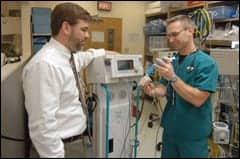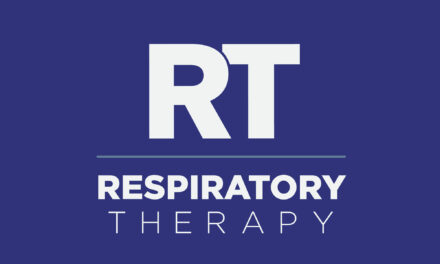RCPs must know the rules of reimbursement if they want to remain viable players in the home health care market.
For many health care professionals, it may seem as though barely a week goes by without word of another government-mandated change in the way health care is being delivered and reimbursed. As these changes continue to affect the health care community, many owners and administrators of home health care dealerships are striving to identify–and remedy–internal problems that may exacerbate the negative impact of such changes.
Operations that use respiratory care practitioners (RCPs) are no exception. Given the rapidly evolving state of health care, RCPs may not always be aware that certain services are unprofitable because payors reimburse them poorly or, increasingly, not at all. When this occurs, it may result in “free” care being delivered, ultimately causing a hardship for RCPs’ employers.
In a recent issue of AARC Times, the official publication of the American Association for Respiratory Care (AARC), Colleen Bittner, MS, CCC-SLP, detailed how one particular provider’s clinicians were systematically–albeit unknowingly–undermining the company. According to Bittner, the provider was under a managed care contract, the capitated amount of which the managed care organization (MCO) kept trimming from year to year because outcomes were so good. Apparently, the MCO felt it was being gouged by the provider. In the MCO’s particular brand of reasoning, the contract amount needed to be reduced to the point where a small but significant decline in outcomes would emerge. Then and only then would the MCO have a sense that it was paying the right amount for services, Bittner reported.
Instead of paring services in step with the incremental reductions in the contract amount, however, the provider’s clinicians maintained previous high levels of care. “They were determined to do whatever it took to continue delivering quality care–which basically meant do it but don’t record it,” the AARC Times quoted Bittner.
Each time the MCO lowered the contract rate, the outcomes remained essentially unchanged because clinicians were determined to keep on doing what they felt was right for patients, Bittner said. Eventually, the cuts reached a depth the provider could no longer endure and remain solvent, she said. Bittner connected the dots of the story for her audience by explaining that clinicians must understand that “giving away” services hurts not only their employers, but also the interests of patients who depend on those providers for care and supplies.
Giving away services can also trigger investigations by the federal government’s Office of the Inspector General, Bittner reported. “If your staff gives services away to some organizations but charges Medicare for those same services, that can be viewed as fraud and abuse,” she cautioned.
Maintaining Appearances
The Medicare cuts that went into effect in January have resulted in a decline in revenues for oxygen suppliers. Industry observers predicted the cuts would not be fully felt until around now, once receivables outstanding from 1997 had been collected and suppliers were operating on a diet of pure postcut revenues. One newsletter serving the industry reported that many of the suppliers it polled either have or soon will scale back the level of respiratory services they offer in order to compensate for the reduction in home oxygen revenues.
Some observers speculate these suppliers may inadvertently end up encouraging RCPs to “give away” services. Insiders predict a big push among suppliers to look as though they are unaffected by the Medicare reimbursement cut. The theory posits that companies may go under if they cannot convince their customers that they are still able to deliver the goods–namely, abundant service.
In the process of promoting the idea that they remain high-service resources, however, home health care companies may give staff the idea that delivering extra care off the books, so to speak, is commendable. “As a manager, you’ve got to nip this problem in the bud,” says Toni Rehkop, CRTT, clinical supervisor with CPO2 Inc, a home health care supplier based in Mifflinburg, Pa. “You’ve got to explain to your RCPs what’s at stake if services are given away free.”
What RCPs must understand about reimbursement is that a new paradigm is in place, says Sam Giordano, MBA, RRT, executive director of AARC. “We are evolving to a capitated payment system wherein demand for health care services must be managed down, which means the incentives for providing service have changed,” Giordano explains. “Under the old system, the more services you provided, the more money your organization made. Under the new system, it’s the opposite–the less you do, the more you make. So, not only is there no longer an incentive to provide services, there is actually a disincentive.”
Some RCPs may mistakenly assume that if a physician orders a service, then the patient must be covered for it by insurance or Medicare. This is not necessarily the case, Rehkop warns. “The fact that you have a prescription means only that you have a prescription,” she says. “What you don’t have is any evidence that the company is going to be reimbursed if you go ahead and provide that service … home care RCPs must understand first and foremost how providers get reimbursed–what a patient needs to qualify for oxygen and equipment, and who is allowed to perform the qualifying.”
Rehkop’s rule of thumb if she has a question about whether a service is reimbursable is to go directly to her company’s billing office for the answers. “The billing office can tell me whether the patient’s health-plan benefits or Medicare will cover the service, whether it looks like something we’re going to need a letter of medical necessity on, do we need supporting documentation from the hospital and labs, and so forth.”
Rehkop notes that Medicare and many third-party private payors have guidebooks and telephone hotlines that RCPs (and administrators, for that matter) can consult with questions regarding the rules for initiating each and every type of service imaginable. AARC, meanwhile, publishes clinical practice guidelines that list the indications and contraindications for each specific disease. These guidelines spell out the circumstances under which the various procedures and pieces of equipment are generally recognized as medically necessary, Giordano says.
“Each of the more than 45 guidelines we have thus far produced is based on an extensive review of published scientific literature, which gives them a very strong underpinning,” he says. By following these guidelines, RCPs and home care providers alike can minimize the risk of having a payor refuse to honor a claim on the grounds that the service delivered was medically unnecessary.
Unlocking The Vault
Medical necessity–the key to unlocking the reimbursement vault–is easy to demonstrate for only a few respiratory-related services. These include oxygen, diagnostic nocturnal pulse oximetry, pediatric apnea monitoring, phototherapy, post-sleep study continuous positive airway pressure (CPAP), and bilevel positive airway pressure for adult obstructive sleep apnea, Rehkop says.
“However, under Medicare rules, we’re not allowed to demonstrate on our own which services are or will be medically necessary,” Rehkop cautions. “That’s something that must be performed independently.”
For example, if a physician gives Rehkop a prescription to set up a patient on oxygen, she must first check with the physician whether the patient has had blood gas and oxygen saturation tests performed by the hospital’s laboratory in conjunction with the request. “If the answer is no, then we can’t go forward,” Rehkop says. Medicare requires that a saturation test, stating the patient’s oxygen level is below 88 percent or the PO2 level is 55 or below, be performed by an independent laboratory, she notes.
“If the doctor asks me to perform pulse oximetry on the patient to verify that the saturation level or PO2 level is abnormal, then I have to explain that because I’m going to be the provider of the oxygen service, I cannot perform pulse oximetry on this patient to say that the oxygen is a medical necessity. The only way this can legally be done is for the physician to send the patient back to the hospital for that test.”
One way to deal with private, third-party payors who refuse to reimburse for medically necessary services provided by RCPs is to refuse to take no for an answer, Rehkop says. “Just because insurance companies and [MCOs] say something isn’t reimbursable doesn’t mean exceptions can’t be made,” she explains. “For example, we offer pressure support ventilation for COPD [chronic obstructive pulmonary disease] patients–a service some private third-party payors refuse to reimburse. However, we’ve learned to identify from the COPD population certain patients who are likely to benefit from pressure support ventilation,” she says. By thoroughly documenting past successes and coordinating closely with referring physicians, Rehkop has been been able to convince several payors to allow–on a restrictive, case-by-case basis–reimbursement for that particular service. “If you can make the patient better and can prove it, the insurance company may be willing to pay for your care after all, since you’re actually saving the payor money in the long run,” she says.
Meanwhile, RCPs should not be obliged to alone bear the responsibility of making sure that only services that will be reimbursed are delivered. Suppliers, too, have a stake in this. Suppliers may be able to help their clinicians avoid stumbling into the reimbursement minefield by equipping them to operate more cost-effectively. If less expense is involved to begin with, it follows that cuts in reimbursement will be less traumatic.
One way to engender greater cost-efficiency where RCPs are concerned might be by setting up a triage system. An RCP makes the initial patient visit, then delegates the task of following up to a lower-level clinician or assistant. In the event the assistant detects a problem with a patient, the RCP can then be brought back into the picture.
Suppliers also can aid cost-efficiency by arranging to educate patients who are not homebound in groups at centralized locations, experts suggest. This can be beneficial in two ways: First, it may curtail clinicians’ travel and free up their time; second, it may allow training to be unbundled from deliveries, which will permit lower-cost technicians to handle setups. Still another cost-efficiency measure would be to move patients into self-care mode at the earliest possible juncture.
RCPs As Consultants
What can be done about ensuring positive outcomes, however, when payors tell you certain respiratory-related therapies will not be reimbursed? The remedy could be to position RCPs as consultants, Giordano suggests. “RCPs not only deliver care but act as consultants to the appropriateness of the care and as consultants responsible for identifying the availability of other care options,” he says.
At a minimum, experts advise, RCPs should join their co-workers from other disciplines and decide as a team how the managed care reimbursement dollars available for each patient will be spent. This can help home health care suppliers avoid counterproductive duplication of efforts that may result when the available dollars are simply divided among the disciplines.
Team decision-making, however, should be informed decision-making, experts caution. This means managers must supply the team with information about how services are being paid. From this, the team should be able to develop a care plan that will appropriately utilize the available dollars and still satisfactorily meet the patient’s needs.
Perhaps the most effective strategy of all is to be proactive. RCPs should participate in the contract negotiations with managed care payors so that, up front, the payor and the supplier have an accurate understanding of the respiratory services patients will need and the dollar amounts necessary to cover those services.
“Start by asking your [MCO] customer contacts if they think reimbursements are out of line in relationship to the outcomes you’re getting,” Rehkop says. “If you receive feedback that suggests they do think the reimbursements are too high, that they think you’re gouging them, that’s the time to call a meeting with the customer, bring in your clinicians, your salespeople, and all your documentation, and prove to the decision-makers that they are receiving tremendous value for the dollar spent, and that by continuing to maintain the current level of reimbursement you will save them X amount of dollars by causing utilizations to decrease X amount.”
The need to manage-down demand affords yet another opportunity to be proactive, Giordano says. “It can be a win-win situation for everybody. In managing-down demand, you have RCPs and other disciplines getting involved with the patient’s care plan to the extent that you are acting in the capacity of a disease state manager. This allows opportunities to be identified whereby the patient’s consumption of health care resources can be downshifted without compromising the quality of care necessary to support that particular patient.”
Says Giordano: “Services are not given away free, and reimbursement dollars are put to the best use possible.”
Rich Smith is a contributing writer for RT.









